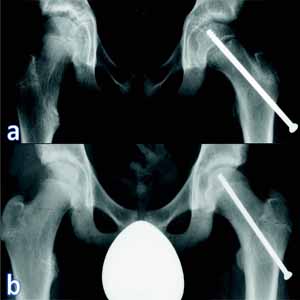Reviews
28 October 2022
Vol. 44 No. s1 (2022)
Management of slipped capital femoral epiphysis: What hardware we can use in osteosynthesis in situ?

Publisher's note
All claims expressed in this article are solely those of the authors and do not necessarily represent those of their affiliated organizations, or those of the publisher, the editors and the reviewers. Any product that may be evaluated in this article or claim that may be made by its manufacturer is not guaranteed or endorsed by the publisher.
All claims expressed in this article are solely those of the authors and do not necessarily represent those of their affiliated organizations, or those of the publisher, the editors and the reviewers. Any product that may be evaluated in this article or claim that may be made by its manufacturer is not guaranteed or endorsed by the publisher.
837
Views
411
Downloads
Authors
Department of Orthopedy and Traumatology, Bambino Gesù Paediatric Hospital, Rome, Italy.
Department of Orthopedy and Traumatology, Bambino Gesù Paediatric Hospital, Rome, Italy.
Department of Musculoskeletal Disorders, Faculty of Medicine and Surgery, University of Salerno, Baronissi, Italy.
Department of Orthopedy and Traumatology, Bambino Gesù Paediatric Hospital, Rome; University of Cassino and Southern Lazio, Cassino, Italy.
Department of Orthopedy and Traumatology, Bambino Gesù Paediatric Hospital, Rome, Italy.
Epiphysiolysis (or Slipped Capital Femoral Epiphysis, SCFE) is a hip disorder involving children during prepubescence age. Traditionally, it is defined as a postero-medial slippage of the femoral epiphysis on the metaphysis, but, considering that femoral epiphysis is almost “stored” in the acetabulum, it could be better defined as laterally and anterior slippage of femoral metaphysis under the epiphysis.
Falciglia F, Aulisa AG, Giordano M, Guzzanti V. Fixation in slipped capital femoral epiphysis avoiding femoral-acetabular impingement. J Orthop Surg Res 2017;12:163. DOI: https://doi.org/10.1186/s13018-017-0663-3
Novais EN, Hill MK, Carry PM, et al. Modified Dunn procedure is superior to in situ pinning for short-term clinical and radiographic improvement in severe stable SCFE. Clin Orthop Relat Res 2015;473:2108–17. DOI: https://doi.org/10.1007/s11999-014-4100-1
Hansson G, Nathorst-Westfelt J. Management of the contralateral hip in patients with unilateral slipped upper femoral epiphysis: to fix or not to fix--consequences of two strategies. J Bone Joint Surg Br 2012;94:596–602. DOI: https://doi.org/10.1302/0301-620X.94B5.28322
Sailhan F, Courvoisier A, Brunet O, et al. Continued growth of the hip after fixation of slipped capital femoral epiphysis using a single cannulated screw with a proximal threading. J Child Orthop 2011;5:83–8. DOI: https://doi.org/10.1007/s11832-010-0324-0
Kumm DA, Lee SH, Hackenbroch MH, Rütt J. Slipped capital femoral epiphysis: a prospective study of dynamic screw fixation. Clin Orthop Relat Res 2001;384:198–207. DOI: https://doi.org/10.1097/00003086-200103000-00023
Guzzanti V, Falciglia F, Stanitski CL. Slipped capital femoral epiphysis in skeletally immature patients. J Bone Joint Surg Br 2004;86:731–6. DOI: https://doi.org/10.1302/0301-620X.86B5.14397
Wensaas A, Svenningsen S. Behandling av epiphysiolysis capitis femoris med spesialkonstruert collumskrue [Slipped capital femoral epiphysis treated with a specially designed screw]. Tidsskr Nor Laegeforen 2005;125:2788-90. Norwegian.
Morash K, Orlik B, El-Hawary R, et al. Femoral neck growth and remodeling with free-gliding screw fixation of slipped capital femoral epiphysis. J Pediatr Orthop 2021;41:e309–15. DOI: https://doi.org/10.1097/BPO.0000000000001770
How to Cite
Management of slipped capital femoral epiphysis: What hardware we can use in osteosynthesis in situ?. (2022). La Pediatria Medica E Chirurgica, 44(s1). https://doi.org/10.4081/pmc.2022.297
Copyright (c) 2022 The Author(s)


This work is licensed under a Creative Commons Attribution-NonCommercial 4.0 International License.
PAGEPress has chosen to apply the Creative Commons Attribution NonCommercial 4.0 International License (CC BY-NC 4.0) to all manuscripts to be published.






